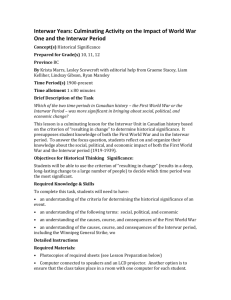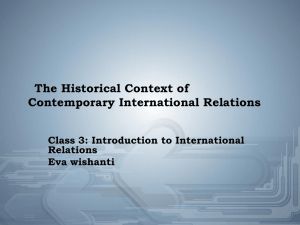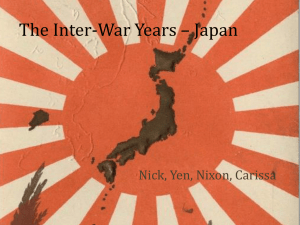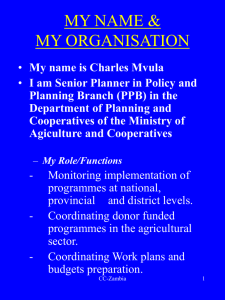The Interwar American Economy: the Rise of Government: Lecture 2
advertisement
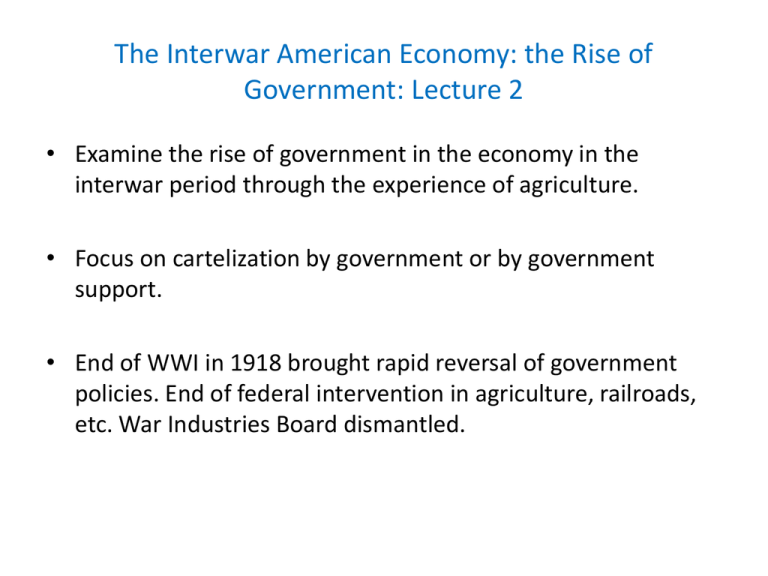
The Interwar American Economy: the Rise of Government: Lecture 2 • Examine the rise of government in the economy in the interwar period through the experience of agriculture. • Focus on cartelization by government or by government support. • End of WWI in 1918 brought rapid reversal of government policies. End of federal intervention in agriculture, railroads, etc. War Industries Board dismantled. The Interwar American Economy: the Rise of Government • Depression of 1920-21, rising unemployment, sharp fall in prices, some estimates as much as 46 %, but then rebound in the general economy. • Farm prices, however, do not recover. Do not return to 1914 levels until 1945! • Input prices however rise, so that overall there is agricultural distress. • Farm foreclosures. Farms use debt. Local banks fail. The Interwar American Economy: the Rise of Government The 1920s—Price drop1921. The Interwar American Economy: the Rise of Government The 1920s—rebound in general economy. The Interwar American Economy: the Rise of Government The 1920s—rebound in general economy. The Interwar American Economy: the Rise of Government The 1920s—some rebound in agriculture, but lack parity with nonagricultural sectors, decline after 1925. The Interwar American Economy: the Rise of Government The 1920s—farm foreclosures. The Interwar American Economy: the Rise of Government The 1920s—outmigration and decline in agricultural employment. The Interwar American Economy: the Rise of Government • 1910-1914 had been viewed as the “golden years” • Considerable political pressure in farm states to do something. Varies by commodities. – Wheat, corn (maize), tobacco, cotton to some degree. – Speciality products—dairy, citrus, fruits, less so. • Lacking experience with peace time intervention of government, no clear consensus as to what to do. • Fear permanent decline. Political issue. • American Farm Bureau Federation. • Grange. The Interwar American Economy: the Rise of Government • Promote private cooperatives to control output and fix prices— government sponsored or endorsed private cartels. – Packers, Stockyards and Grain Futures Act of 1921—require “fair” prices. – Capper Volstead Act 1922—Promote cooperatives via price information sharing. – Fordney-McCumber Tariff—1922 high duties on most agricultural imports. – Cooperative Marketing Act 1926—Anti-trust exemption and USDA. – McNary-Haugan Legislation 1924, 1928—Fair exchange values. 190514 prices. Private cooperatives purchase, dump overseas, tariffs. WWI. – Agricultural Marketing Act 1929—Federal Farm Board to buy, store, sell commodities. Too little. – Hawley Smoot Tariff 1930. Cartel Theory and the Problem of Large Numbers and Heterogeneity The Interwar American Economy: the Rise of Government • Problem of cartel cheating and compliance when numbers are very large, entry easy, monitoring difficult. Free riding. • Question: What are the factors that promote cartel compliance? – – – – – Numbers Homogeneity of cost and production Homogeneity of product Observability of compliance/cheating Entry controls—new entrants (foreign and domestic), stocks or inventories. – Established organizations – Amount of cuts needed – Observable impact of collective action on prices The Interwar American Economy: the Rise of Government • Specialty crops—dairy, citrus, fruits—more local, observable, entry more difficult, established cooperatives. Accordingly, demanded less intervention initially, but also more difficult as we will see. • General commodities—wheat, corn (maize), other grains, cotton, tobacco, more broadly spread, ease of entry, many producers and shipping points, stocks durable, international competition, local cooperatives less effective. Defection. Demanded intervention. The Interwar American Economy: the Rise of Government The problem of cooperative cartelization of corn producers: The Corn Belt The Interwar American Economy: the Rise of Government The problem of cooperative cartelization of wheat producers The Interwar American Economy: the Rise of Government The problem of cooperative cartelization of tobacco producers The Interwar American Economy: the Rise of Government The problem of cooperative cartelization of cotton producers The Interwar American Economy: the Rise of Government The problem of cooperative cartelization of specialty fruit crops The Interwar American Economy: the Rise of Government The problem of cooperative cartelization of livestock raisers. The Interwar American Economy: the Rise of Government • Why the difference across agricultural groups? Consider cartel theory. See support by region for McNary Haugen in Hoffman/Libecap 1991, Table 4. • American Farm Bureau Federation. – Local county offices set local production quotas. – State office to coordinate. – National prices and output. • Why was the 1905-14 price chosen? • Need major cuts in output. The Interwar American Economy: the Rise of Government • What would be the impact on consumers/taxpayers if successful regulation? • What are the general equilibrium effects? Other consumption, saving, expenditures, international trade if major agricultural program put into place? • What if some regions/producers were naturally more productive than others? How would these constraints affect them? The Interwar American Economy: the Rise of Government • In the end, no major federal agricultural program was implemented in the 1920s, but the basis for subsequent expansion was established. Needed a crisis. • This came with the Great Depression and the overall collapse in the economy, and in particular, in agriculture. • We will not focus on the Great Depression in general, but on its implications for agricultural regulation and the growth of government. The Interwar American Economy: the Rise of Government • The Great Depression discredited markets or at least caused severe anxiety about employment, production, and the future. • More attention to the potential role of government to intervene. – Keynesian policies (not directly adopted by the U.S. government). – Local and state governments weakened. Balance budget requirements, but faced with falling tax revenues. Cut back. – WWI had demonstrated a role for government intervention and many former administrators (bureaucrats) saw their opportunities rising to return. The Interwar American Economy: the Rise of Government – Observations of foreign actions involving government intervention— Soviet Union, Germany, Italy, Great Britain. – The collapse in GNP and high unemployment broadened political appeal for intervention at the federal government level and lowered the political costs (tax payers and constituents that might be harmed). – Key constituent groups: Major commodity farmers; federal labor force; – Shift in views by leading economists in calling for government expenditures and price fixing. Keynes, Pigou—to some degree, Minimum wages. Deposit insurance. Unemployment insurance. CCC. Agricultural and Industrial programs. Democrats. The Interwar American Economy: the Rise of Government – Opposition from balanced budget and small government groups: Republicans. Later from market supporters who viewed price fixing as damaging—Austrian economists, Von Mises, Hayek. – Hoover loses in 1932. Roosevelt wins. – Even so, no endorsement of Keynesian economics. State and local cut back as federal government expenditures rise. – Concern about inflation and balanced budget in 1936. Depression returns. – No industrial policies, but agricultural policies remain. Why and what form did agricultural policies take? – Focus of lecture 3.
